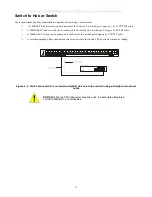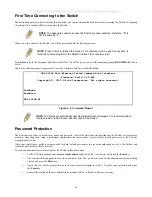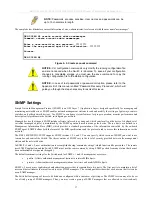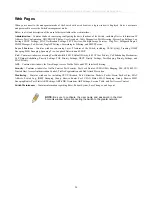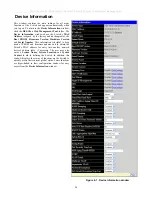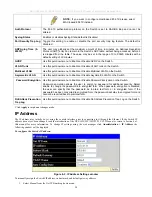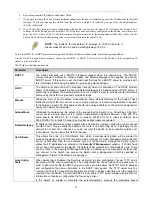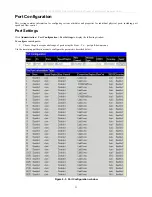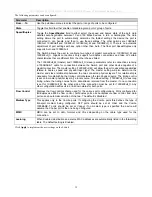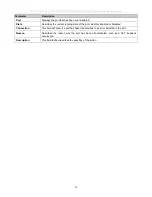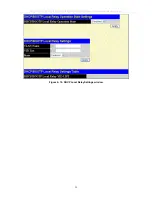
DES-3028 DES-3028P DES-3028G DES-3052 DES-3052P Layer 2 Fast Ethernet Managed Switch
27
The fields that can be configured are described below:
Parameter Description
System Name
Enter a system name for the Switch, if so desired. This name will identify it in the Switch
network.
System Location
Enter the location of the Switch, if so desired.
System Contact
Enter a contact name for the Switch, if so desired.
Serial Port Auto
Logout Time
Select the logout time used for the console interface. This automatically logs the user out after
an idle period of time, as defined. Choose from the following options:
2 Minutes, 5 Minutes, 10
Minutes, 15 Minutes
or
Never
. The default setting is
10 minutes
.
Serial Port Baud Rate
This field specifies the baud rate for the serial port on the Switch. there are four possible baud
rates to choose from,
9600
,
19200
,
38400
and
115200.
For a connection to the Switch using
the CLI interface, the baud rate must be set to
9600
, which is the default setting.
MAC Address Aging
Time
This field specifies the length of time a learned MAC Address will remain in the forwarding
table without being accessed (that is, how long a learned MAC Address is allowed to remain
idle). To change this, type in a different value representing the MAC address age-out time in
seconds. The
MAC Address Aging Time can be set to any value between
10
and
1,000,000
seconds. The default setting is
300
seconds.
IGMP Snooping
To enable system-wide IGMP Snooping capability select
Enabled
. IGMP snooping is
Disabled
by default. Enabling IGMP snooping allows you to specify use of a multicast router only (see
below). To configure IGMP Snooping for individual VLANs, use the
IGMP Snooping
window
located in the
IGMP Snooping
folder contained in the
L2 Features
folder.
Multicast Router Only
This field specifies that the Switch should only forward all multicast traffic to a multicast-
enabled router, if enabled. Otherwise, the Switch will forward all multicast traffic to any IP
router. The default is
Disabled
.
MLD Snooping
This field specifies the status of MLD Snooping on the Switch. MLD Snooping is used to
discover ports on a VLAN that are requesting multicast data instead of flooding all ports on a
selected VLAN with multicast traffic. The default is
Disabled
.
Telnet Status
Telnet configuration is
Enabled
by default. If you do not want to allow configuration of the
system through Telnet choose
Disabled
.
Telnet TCP Port
Number (1-65535)
The TCP port number. TCP ports are numbered between
1
and
65535
. The "well-known" TCP
port for the Telnet protocol is
23
.
Web Status
Web-based management is
Enabled
by default. If you choose to disable this by selecting
Disabled
, you will lose the ability to configure the system through the web interface as soon as
these settings are applied.
Web TCP Port Number
(1-65535)
The TCP port number. TCP ports are numbered between
1
and
65535
. The "well-known" TCP
port for the Web is
80.
RMON Status
Remote monitoring (RMON) of the Switch is
Enabled
or
Disabled
here.
Link Aggregation
Algorithm
The algorithm that the Switch uses to balance the load across the ports that make up the port
trunk group is defined by this definition. Choose
MAC Source
,
MAC Destination
,
MAC Src &
Dest
, (See the Link Aggregation section of this manual).
Switch 802.1X
MAC Address can be enabled by port or by the Switch’s 802.1X function; the default is
Disabled
. This field must be enabled to view and configure certain windows for 802.1X. More
information regarding 802.1X, its functions and implementation can be found later in this
manual, under
Monitoring >
Port Access Control
.
Port-Based
802.1X specifies that ports configured for 802.1X are initialized based on the port
number only and are subject to any authorization parameters configured.
MAC-based
802.1X specifies Host-based authentication with which the ports configured for
802.1X are initialized based on the MAC address of the computer being authenticated.
Summary of Contents for DES-3028
Page 306: ......
Page 307: ......
Page 327: ...D Link D Link D Link D Link 7 495 744 00 99 http www dlink ru e mail support dlink ru...
Page 332: ...Technical Support Web Web URL http www dlink jp com...

